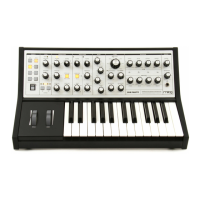11
BASICS OF SOUND CONT.
Amplitude—the intensity of vibration—determines a sound’s loudness. A high-amplitude sound is
loud, and a low-amplitude sound is soft. A vibrating source’s loudness depends on the amount of air it
displaces, and that depends on how hard it vibrates.
It’s difficult for anyone to identify a musical instrument simply by the pitch or loudness of the sounds
it makes. Every musical sound also has a characteristic tone color or timbre (pronounced tam’–br, as
in tamborine, not tim’–br, as in a tree falling). Differences in timbre make it possible to distinguish one
instrument from another.
If you analyze a single cycle of a musical sound, you can perceive it as a complex combination of
simple sine waves, each wave different in frequency and amplitude. When their frequencies are whole-
number multiples of each other (and in musical sounds, they usually are), those simple waves are called
harmonics. A sound’s timbre depends on its harmonic content. The first harmonic—the one with the
lowest frequency and usually the greatest amplitude—determines its pitch. Higher harmonics are often
called overtones. Normally, the higher the overtone’s frequency, then the weaker its amplitude.
When those harmonics are combined in a musical sound, a single cycle of that sound has a specific
shape, which synthesists call a waveform. Just as the frequencies and relative amplitudes of the
sound’s harmonics determine its waveform, the waveform determines the sound’s timbre.
Instead of producing sounds acoustically the way vibrating objects do, synthesizers generate electrical
signals that are amplified and converted to sound. Just as sound has frequency and amplitude, so
does the kind of alternating current produced by a synthesizer. An analog synthesizer’s primary sound
source is called an oscillator.
The oscillator’s waveform, of course, determines the sound’s harmonic content. Some waveforms
are rich in harmonics, while others have relatively few. Depending on the waveform, some overtones
may be absent altogether. Waveforms with lots of overtones, such as sawtooth and square waves, are
harmonically the most complex. Waveforms with fewer overtones, such as triangle and narrow pulse
waves, are harmonically less complex.
Rather than building up waveforms one harmonic at a time, the way a Hammond organ does, analog
synthesizers like the Sub Phatty provide the means to shape and filter complex, harmonically rich
waveforms to selectively remove, reduce, or emphasize specific harmonics—a technique called
subtractive synthesis.
KB: Keyboard (Pitch Voltage)
VCO: Voltage Controlled Oscillator
VCF: Voltage Controlled Filter
EG: Envelope Generator
LFO: Low Frequency Oscillator
VCA: Voltage Controlled Amplifier
The Subractive Synthesis Model

